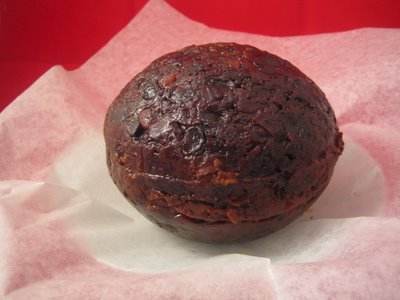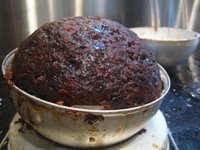 . . . and another new tradition for me . . . mincemeat!
. . . and another new tradition for me . . . mincemeat!Two kinds - one with meat, real meaty meat and one without, like we know it now-a-days. Looking at the picture above, the one with minced beef is on the right, I was surprised how light coloured it is, especially in comparison with the very dark non-meat mixture on the left. I am yet to find out how either tastes ; but I am dying to know if I can tell the difference and if the real-meat mincemeat is less sweet and sickly as Hugh promises. I will let you know! But if the meat mincemeat pies are not to our taste the mixture apparently make a wonderful stuffing for pork. Either way I win!
I haven't made very much because I only wanted a little, so multiply to your requirements.
Sterilise some jars before making these mincemeats by preheating the oven to 120°C and heating some clean jars and their lids for an hour. Once the jars are filled they will keep a while but can be used after a week or so. Turn the jars the other way up every so often to allow the liquid to permeate.
Real meat mincemeat
from The River Cottage Year
makes 550mL
125g finely minced good beef
60g beef suet, grated
60g each of currants and raisins
1 apple, peeled, cored and chopped
50g dark muscovado sugar
35g ground almonds
25g preserved ginger in syrup, chopped, plus 1T of the syrup
25g mixed peel
grated zest and juice of a lemon
1/4 teaspoon freshly grated nutmeg
1/2 teaspoon mixed spice
60mL Cognac
Mix everything together thoroughly and store in the sterilised jars for a week or so before using to make mince pies (or to stuff pork!).
Mincemeat
from Tamasin's Kitchen Bible
makes 600mL
110g each of sultanas, raisins and currants
60g of blanched almonds, chopped
1 apple, cored and chopped
135g dark muscavado sugar
65g mixed peel
grated zest and juice of an Orange
1/3 t freshly grated nutmeg
cloves, cinnamon and mace, ground to make 1/2t total
1/2t freshly grated ginger
55g beef suet, grated
1T dark rum
50mL Cognac
Mix everything together thoroughly and store in the sterilised jars for a week or so before using to make mince pies.
Check Morsels and Musings for other Festive Food Fair fare.








